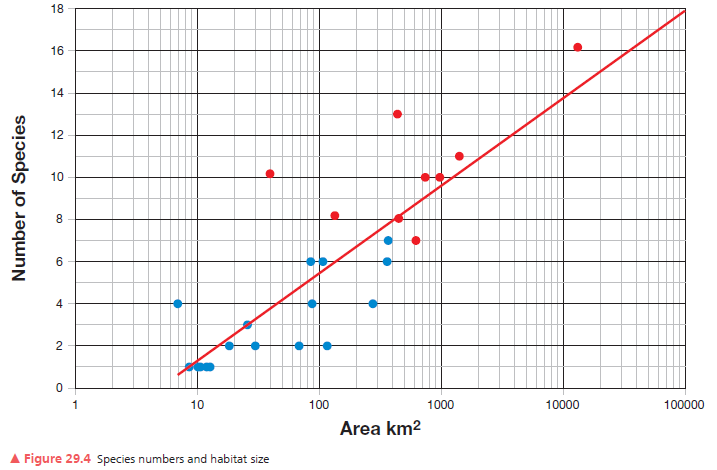Based on your answers to Questions 7 and 8, are larger or smaller habitats more prone to species loss due to reduction in habitat size? If you were identifying habitat to protect, would you recommend protecting one 400 km2 area or four 100 km2 areas? What other factors might you consider? What factors would make a species more deserving of protection? Are all species deserving of equal protection?

Use Figure 29.4 and the trend line to answer the question.
The smaller habitat had a greater spp loss due to a halving of area. This suggests that larger habitats are less prone to spp loss. However, other factors to consider include the types of habitats. Protecting four smaller areas that are all different habitats could be more important than one larger area with one habitat type. When designing protected areas for species conservation another consideration could be what type of organisms are being protected. Birds would have very different requirements than tortoises. Protecting four species of ant might be viewed as less important than protecting one endangered species of a larger organism, such as panda bears or spotted owls or salmon.
You might also like to view...
What may have prevented the use of bioplastics in the past century?
A. The technology for mass production of bioplastics was not yet available. B. The materials needed for bioplastics was used for food. C. Bioplastics were viewed as inferior materials. D. Oil became widely available and petrochemical plastics took over the market. E. Synthetic plastic producers had a strong government lobby.
Isostasy is
A. the buoyant force exerted on the mantle by continental crust. B. the positioning of the crust in response to the buoyant force and gravity. C. the buoyant force exerted on the mantle by oceanic crust. D. the force of gravity acting on the crust.
As part of the Columbian Exchange, which of the following agricultural products, common in Americas today, was actually transported over from Europe?
a. onions b. melons c. lettuce d. soybeans e. all of these agricultural products were brought over from Europe
Streams in rainy regions tend to be ________ the saturated zone; as such, we call them ________ streams.
A. disconnected from; gaining B. connected to; gaining C. connected to; losing D. disconnected from; losing